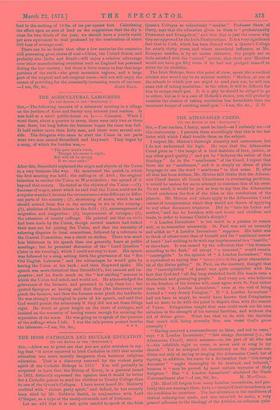LETTERS TO THE EDITOR.
WIND versus COAL.
[TO THE EDITOR OF THE "SPECTATOR."]
Sin,—Your correspondent, " A. Non-Expert," suggested in your paper of the 8th inst. that although the exhaustion of her coal- fields may at some future time render England relatively weaker than her rivals in productive industry, her absolute supply of avail- able force may remain as at present, inasmuch as the wind may be used to supply the deficiency.
I regret that some one of our able professors of physics has not undertaken to show to your correspondent the fallacy of this ex- pectation, as he would doubtless present the subject more fully and vividly than I can hope to do, especially as I write at a dis- tance from works of reference ; but with your permission, I wish to suggest some considerations that may show how slight is the value of the wind as a motive power in comparison with other forms of energy.
The wind observations in these islands, taken chiefly at stations on or near the coast, show that in ordinary weather the pressure rarely exceeds 3 lbs. to the square foot, or one-third of an ounce to the square inch ; and even this is diminished at inland stations. With a fall of 10 ft. we may get a pressure of 5 lba. to the square inch on a water-wheel, and a pressure of 50 lbs. to the square inch is ordinarily obtained in the cylinder of a locomotive engine. Very well, some one may answer, why should we not make the surface of our wind machine 240 times as large as that of the buckets of the water-wheel, or 2,400 times as large as that of the locomotive-engine cylinder, and thus get as much power as these can supply? But the objector forgets that as you increase the surface to be acted on by the wind, you must increase the bulk and weight of the machinery, and all the more because this must be strong enough to resist occasional violent pressure twenty times greater than the ordinary average amount. All this means a vast and disproportionate increase of friction, so that in practice only a small residue of the moving force is available for use. Let "A Non-Expert" inquire into the cost of erecting a windmill, and the amount of work performed by one of these cumbrous machines, and he will find it easier to understand why the wind has served man's mechanical needs to so limited an extent, even in countries where other means of obtaining power are deficient. It is only at places lying within the trade-winds that there is a reasonable prospect of obtaining, on a very limited scale, some practical applications of the mechanical force of the wind.
I have left out of account several rather obvious considerations that go to strengthen the argument. It is not only that the force of the wind is, under ordinary circumstances, insufficient to give an adequate result ; it is in this climate proverbially uncertain, and variable within short intervals both in amount and intensity. Again, as the seemingly inevitable step in the conversion of fluid motion to ordinary uses is to cause rotation to a wheel or screw, there is the great disadvantage that the air machine has to act altogether within the fluid whose motion is to set it to work, so that the resistance bears a large proportion to the amount of available force.
The force of falling water is to an indefinite extent more avail- able for man's use than that of the wind, but even this may probably be supplanted by those more intense forms of energy that depend upon molecular action. When we recollect that the energy of a considerable stream with a fall of 10 ft. working for a day of twelve hours is not equivalent to more than that produced by the combustion of 4 lbs. of charcoal, we get a measure of the vast superiority of the molecular over what we commonly call mechanical agencies.
The great practical discovery which Id some future time will profoundly modify the productive powers of our race is the con- version of solar radiation into some convenient and available form of chemical energy. The sun's rays falling vertically on a sheet of ice will melt a thickness of one inch in two hours and twenty minutes. Allowing for diminished effect at oblique incidence, we may reckon the effect on a clear day within the tropics as equiva- gent to the melting of 18 lbs. of ice per square foot. Calculating the effect upon an acre of land on the supposition that the sky is elear.for two-thirds of the year, we should have a yearly result per acre equivalent to that produced by the combustion of about SOO tons of average coal.
There can be no doubt that after a few centuries the countries still possessing great stores of coal—China, the United States, and probably also India and Brazil—will enjoy a relative advantage ever other manufacturing countries such as England has possessed during the last century ; but there is little reason to fear that large portions of the earth—the great mountain regions, and a large part of the tropical and sub-tropical zones—will not still enjoy the means of providing for the constantly increasing wants of our race.



































 Previous page
Previous page